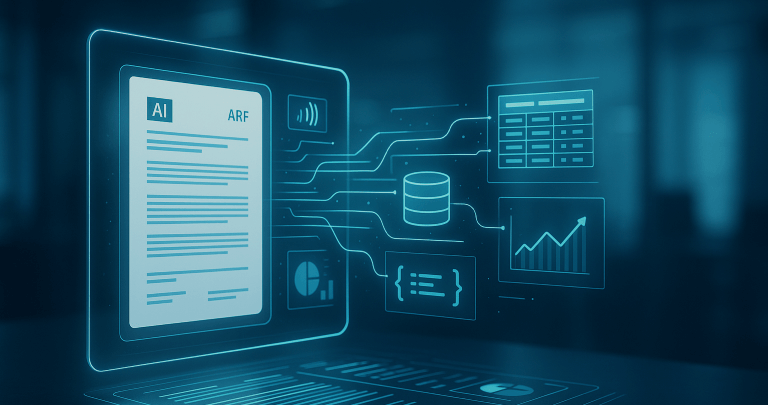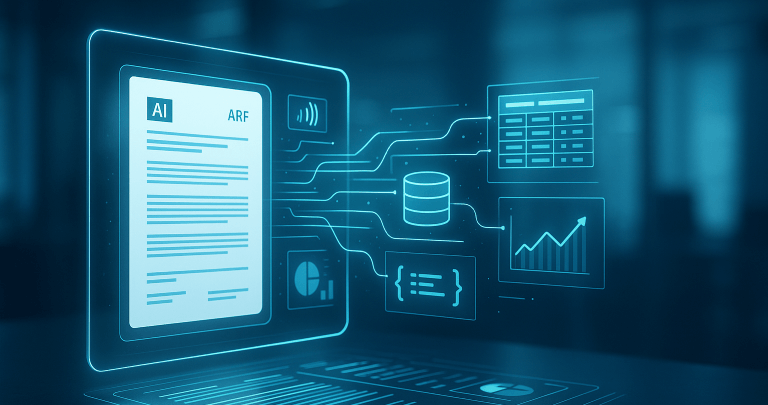How to unlock visual intelligence in your documents beyond OCR and beyond plain text


In a world drowning in documents, such as contracts,
invoices, legal forms, medical records, reports, spreadsheets, images, scanned pages, handwritten notes etc., the challenge
isn’t just storage. It’s meaning. How much of the information buried in all those PDFs and scans goes unused,
misinterpreted, or lost forever?
Enter Agentic Document Extraction (ADE): a new paradigm
in visual AI that doesn’t just read, it understands. It doesn’t just convert images to text, but retains layout,
structure, context, and even the spatial relationships between elements. This isn’t just next-gen OCR (Optical Character
Recognition); it’s a smarter way to turn unstructured documents into powerful knowledge engines.
Why agentic document extraction matters
Traditional OCR
has serious limitations. It extracts raw text but loses structural details like tables, charts, form fields, checkboxes. Without
structure and visual context, answers derived downstream (for research, analytics, or automation) often hallucinate, mislead,
or force heavy manual cleanup.
Agentic Document
Extraction adds visual grounding: each extracted element (a table, a chart, an image caption, a form field) is tagged with
its exact location in the document via bounding boxes. That allows verification, audit trails, traceability.
It handles complex
layouts (multi-column formats, mixed images and text, forms, reports, charts), all without requiring pre-designed templates
or layout-specific training. That means less manual rule-writing, more scalability across document types.
It produces LLM-ready
structured data (JSON, Markdown) fit for downstream applications: Retrieval-Augmented Generation (RAG), search, analysis.
Faster extraction means faster insights. For example, LandingAI claims median processing times dropped from about 135 seconds
to 8 seconds for many documents.
The scale of
the problem
The volume of documents
humanity generates per day is colossal, and growing. We generate billions of images, PDF documents, scans and reports across
sectors every year. Every business, institution, government agency has archives full of locked-information, still in formats
that are hard for machines to reason with.
As AI gets more
powerful, value shifts from mere data accumulation to data usability: how structured, accessible, verifiable that data
is. This is core to computer scientist and entrepreneur Andrew Ng’s philosophy: more than just having data (or compute),
the quality, structure, contextual grounding matter.
As visual AI becomes
mainstream, systems like ADE shift the bottleneck. Instead of “Can we get the data?”, the question becomes “How
accurate and trustworthy is what the system extracts?” Visual grounding, schema-driven field extraction, layout-agnostic
parsing, all reduce errors, reduce manual checks, and increase trust.
Key features
& what ADE can do
Here are some of
the standout capabilities offered by Agentic Document Extraction, which illustrate how it solves the real pain points.
Field extraction
with custom schemas
You pick which fields
matter (invoice number, date, amounts, vendor, etc.), and ADE returns just those fields, validated and grounded. Saves time,
reduces noise.
Complex visual
layouts, tables, charts, checkboxes
Documents aren’t
uniform. ADE handles mixed formats with no need to standardize layout in advance.
Visual grounding
& coordinate metadata
If someone questions
a result (for audit, regulation, or just quality), you can trace it back visually. This boosts trust and reduces risk.
Speed & scalability
Processing time
improvements (e.g. 17 times faster for many use cases) make it viable even for large document archives or high-volume workflows.
Template-free,
layout-agnostic parsing
No need to constantly
build rules or retrain for each document format. Works across PDFs, images, scans.
Use cases: who
benefits & how
Finance and Banking
Automatic extraction
of financial statements, invoices, compliance docs, risk assessment. Faster loan processing. Regulatory auditing with traceable
data.
Healthcare
Medical forms, lab
reports, patient histories. Extracting metrics, analyzing trends. Avoiding manual transcription errors. Ensuring full context
in patient data.
Legal and Insurance
Contracts, claims,
policy forms. Key clauses, dates, agreements. Verification and traceability are crucial.
Logistics and
Supply Chain
Bills of lading,
customs forms, delivery manifests. Minimizing delays. Enhancing transparency.
Public Sector
& Governance
Permits, census
data, public records. Unlock value from archives. Increase accessibility.
How Visionnaire
can help with our AI Factory expertise
At Visionnaire,
we are not outsiders to this transformation. As a Software & AI Factory with deep experience in Visual AI, NLP, and enterprise
systems, here’s how we can support businesses of any size and sector to harness Agentic Document Extraction.
With assessment
& strategy design, we work with you to map out where your documents are, what formats they have, what “fields”
or information are most critical. We define ROI metrics (time saved, error reduction, throughput, etc.).
Before full-scale
rollout, we build prototypes that integrate ADE (or similar visual document understanding tools), test on real documents,
measure accuracy, refine schemas, build trust with stakeholders.
Once you trust the
extraction, Visionnaire helps embed it into your systems (ERP, CRM, backend databases, analytics, or RAG systems). We ensure
that data flows from extraction into business actions with minimal friction.
For sectors with
special needs (medical, legal, finance, compliance), we customize extraction schemas, fine-tune for specific layouts, handle
handwritten inputs when necessary, ensure data privacy and governance.
For monitoring,
Quality Assurance, and trust, we implement validation loops, feedback systems, error correction, visualization of visual grounding
so that users can always trace outputs back to sources. This is crucial for high-risk sectors.
As your document
volume grows, we ensure performance scales (batch processing, cloud infrastructure, API-based pipelines), keep models up to
date, adapt schemas when forms or document types change.
Why now is the
time
Visual AI tools
like ADE are maturing: speed, accuracy, flexibility are reaching levels that make enterprise deployment realistic, not experimental.
The cost of not acting is growing: every manual step, every misinterpreted document is wasted time, risk, lost opportunity.
Regulatory, compliance,
audit, and transparency demands are increasing: being able to trace what your AI outputs back to original documents is becoming
not optional but required in many industries.
Conclusion
Agentic Document
Extraction shifts the equation. Documents transform from static archives or bottlenecks into dynamic, trustworthy reservoirs
of knowledge. With visual grounding, structure, speed, and schema-driven extraction, businesses can finally unlock the latent
potential in their document ecosystems.
And with Visionnaire’s
expertise as an AI Factory, we can help you harness this power, whether you’re a startup, a mid-sized business,
or a large enterprise; whether your documents are neat or messy, modern or archival. We can partner to build a system that
delivers value fast, reduces risk, builds trust, and turns “too many documents” from a burden into a competitive
advantage. Click here to learn more.
See for yourself
You can experience
our advanced AI expertise in extracting content from PDF documents with our Document Extractor. Our tool understands
the context of PDF files and extracts all data in an organized manner. Click here
to try it for free.




